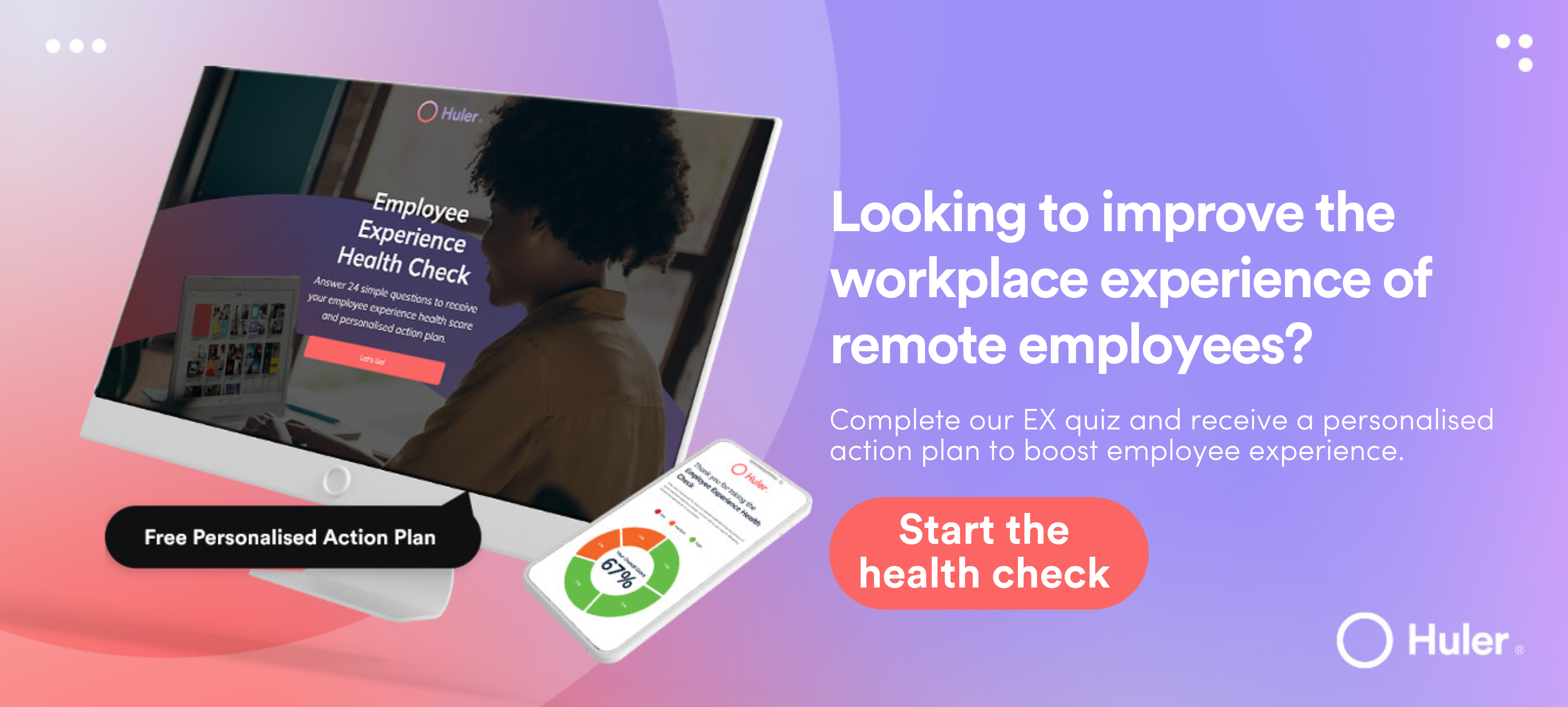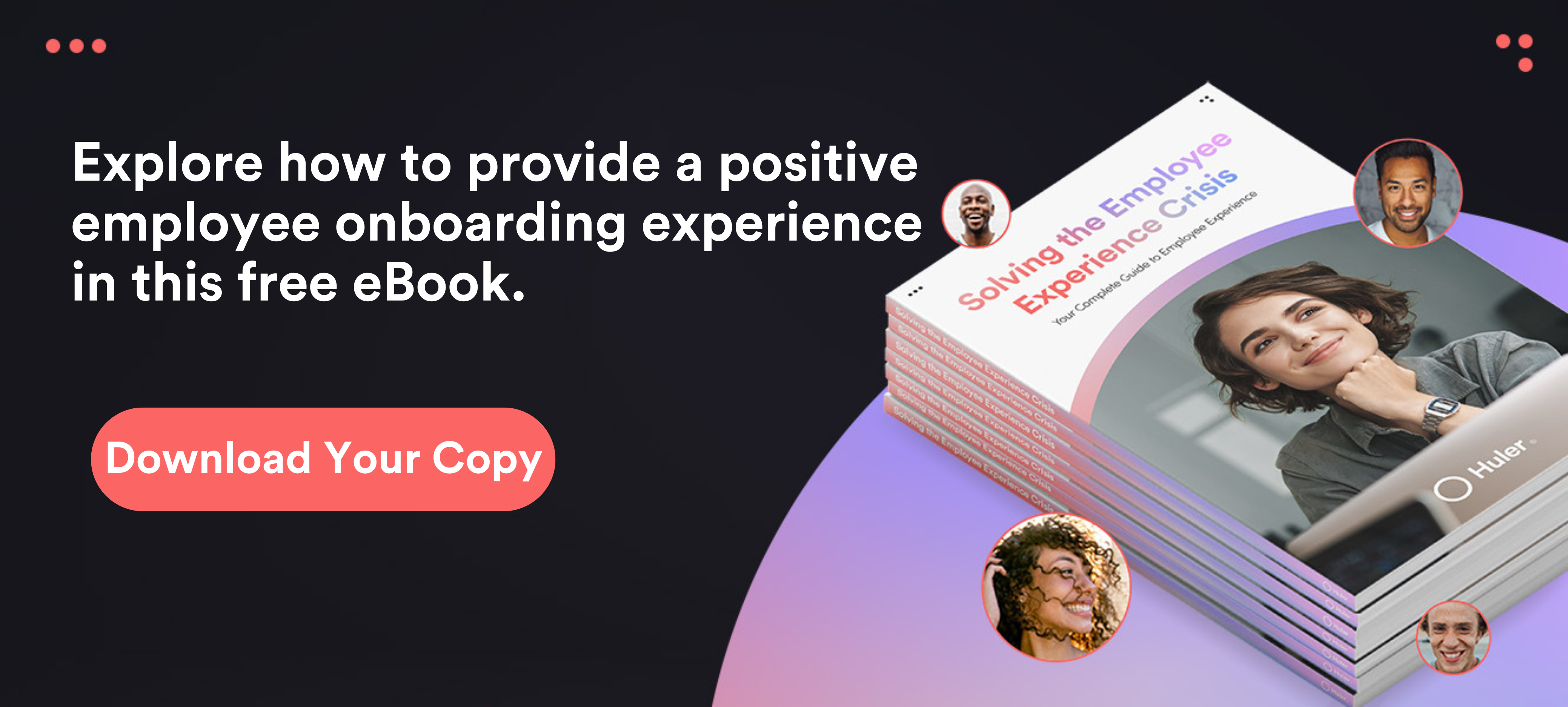Employee experience is a hot topic of late. And rightly so! After all, employees form the beating heart of any and all organisations. Why on earth wouldn’t we want to spend more time making sure they get the best experience?
Many HR departments are looking to improve the digital employee experience for better engagement and wellbeing. Not to mention for keeping productivity high and absences low. But it seems there is a bit of a disconnect between what we should be doing to create a great employee experience and the practicalities of doing so.
In this article, we are taking a deep dive into the wonderful world of employee experience. We will look at what employee experience means, how it relates to employee engagement, the challenges facing businesses looking to build a great experience, and how you can overcome them to supercharge your employee experience.
What Is Employee Experience?
Employee experience refers to the experience employees have in an organisation, starting at the recruitment process and continuing right through to their departure. It lives within the employee journey (or lifecycle) and is shaped by factors such as company culture, the physical work environment, learning and development opportunities, communication, team dynamics, and quality leadership.
Back in 2016, Airbnb became pioneers in employee experience when they pivoted to focus on building a welcoming and inclusive culture. Starting with an inspiring mission statement (“to create a more connected world”) and carrying through to their ‘belong anywhere’ office environment.
The result? Airbnb was crowned number one in Glassdoor’s list of Best Places To Work in 2016 and set the standard for employee experience in organisations the world over.
What Can We Learn From Airbnb?
While we can’t always ensure employees have a good day every day, we can reshape the employee journey into one that puts people over processes. In doing this, it is possible to create touchpoints that leave employees feeling good about their role, contribution, team dynamic, and company.
Suggested reading: Explore the tools that can help you improve employee experience by reading our blog: ‘What is an Employee Experience Platform?‘
Why Is Employee Experience Important?
So, why is employee experience so important? Why are big organizations like Airbnb, Google, and Microsoft investing megabucks into making their employees happy? Isn’t the customer experience is more important?
Yes, customer experience is important. But employee experience also has a tangible impact on growth and success. How? Let’s talk about it…
It Helps Attract & Retain Top Talent
When your employees are happy, they are less likely to leave. 87% less likely, according to research by Gartner.
We all know how expensive and time-consuming it is to recruit, onboard, and train employees. So, it makes good business sense to invest in initiatives that keep employees happy and less likely to jump ship.
What’s more, when you have an excellent culture and employee experience, it makes your organization a magnet for top talent. And who wouldn’t want that for their business?
Employees Are More Engaged, Productive, and Ambitious
This one goes without saying. But we’ll say it anyway.
When employees are excited to work for you, they work harder. Not just for themselves but everyone else.
Research by Harvard Business Review found that businesses that invested heavily in employee experience were included 28 times as often among Fast Company’s Most Innovative Companies and 2.1 times as often in Forbes’ list of the World’s Most Innovative Companies. In the same research, evidence also showed that, compared with other companies, organizations with an experiential focus had more than four times the average profit and more than two times the average revenue.
Put simply, what’s good for your employees is good for your business. No ifs, no buts, no coconuts.
A Focus On Employee Experience Leads To Better Customer Experience
Customer experience and employee experience are undeniably symbiotic – that is, one feeds the other.
Research has shown that companies with highly engaged employees outperform their competitors by 147%.
When employees have a good experience within an organization, they perform better and provide the best CX possible. What’s more, all that positivity shines through in the way they talk about your organization and how quick they would be to recommend it to others.
While the default position for most companies is to focus heavily on the customer experience, those looking inwards are seeing huge ROI for their efforts in the form of an improved customer journey and all the benefits that come with it.
Is Employee Experience The Same As Employee Engagement?
Employee experience and employee engagement are used interchangeably sometimes. But there are key differences between the two.
Crucially, employee experience is the experience employees have within an organization. Employee engagement measures how engaged an individual is with their work and company culture.
Employee experience feeds employee engagement, but they aren’t the same thing.
When organisations look at employee engagement as a separate entity, the onus is put on the employee to engage more, rather than what the business can do to change it. Namely: what are we doing to create an experience that encourages natural engagement?
Employee experience takes a bottom up approach. It welcomes an individual into the organisation during the recruitment process and remains consistent throughout their journey, giving them a good reason to engage with the corporate culture, their colleagues, their job role and opportunities presented to them.
What Are The Main Touchpoints Of The Employee Experience Journey?
It’s not realist to expect an employee to have a good experience every day of their working life. There are too many factors to control if you drill down to the minutiae of every day.
What we can do, however, is break the employee journey down into key touchpoints and ensure the experience at each of these points is one that aligns with your mission statement and core values.
The main touchpoints of the employee journey are:
- Recruitment
- Onboarding Process
- Growth
- Exit
At each point of this journey, leaders, managers, and HR teams shape the employee experience for better or worse.
Recruitment
The employee experience starts at the recruitment stage. At this point, it’s crucial to set a precedent from the get-go when it comes to employee experience by being:
- Honest
- Flexible
- Communicative
- Welcoming
From your job adverts to your interview stages, there are many opportunities to show off and reaffirm your organisations employee experience to potential new recruits.
Starting on the right foot sets the stage for new hires. It will make them excited to work for you and enthusiastic about their new role. As well as this, it will also ensure unsuccessful applicants walk away feeling good about their experience, meaning they might be more inclined to apply again in the future or recommend your organisations to others in a positive light.
Onboarding
A good employee experience during the onboarding stage of the employee journey is essential for retention. According to Peakon, 30% of job seekers have left a job within the first 90 days, which clearly tells us that a good number of employees aren’t afraid to vote with their feet if they aren’t feeling their new job.
According to a recent survey by CareerBuilder, nearly 75% of hiring managers and HR professionals said that their onboarding process lasts one month or less. Yet, research suggests that longer onboarding programs can increase new hire retention by 25% compared to shorter, transactional onboarding processes.
While it might be tempting to let the onboarding process happen naturally after your initial induction process, the opposite is clearly needed. At such an early stage it is everyone’s responsibility to reflect your culture and values. That starts with induction, where you make introductions, get all the paperwork done, and ensure your new hire has everything they need. But it doesn’t end there.
Onboarding is much more than a one-day or one-week process. Those first 90 days are crucial to nurturing your new hire, showing them the ropes, helping them build relationships, and empowering them with the tools they need to succeed, without overwhelming them.
Growth
Beyond giving your employees everything they need to be successful; they also need space to grow and develop their skills.
Once a new starter has found a groove within the business, their minds will naturally turn to growth and development. It’s our job to anticipate that within the employee experience.
When you map the employee journey, factor growth into your plan. Does your organization offer eLearning courses or access to online learning resources? Are there any areas that they would like to grow and develop in specifically? If so, how do you go about that?
The process is much more involved than just throwing a learning experience platform at staff and letting them get on with it. Think mentoring, bespoke training courses, access to conferences, formal qualifications, on the job experiences, regular meetings with their managers and much more.
This process starts by having open, two-way conversations with employees, but actions speak much louder than words. Don’t just pay lip service to CPD. Instead, begin the employee experience with an understanding what your people need and begin to pave a way to facilitate that with the resources and expertise you already have.
Exit
While you can go a long way to retaining talent through a great employee experience, some people will inevitably move on. And that’s okay!
But this final stage should be still be a considered, positive one. For examples, exit interviews that take a no-holds-barred approach demonstrate that your organization is keen to know why someone is leaving and what could be done in the future (if anything) to change that.
Oh, and you should also buy them a card and wish them well for the future too!
Challenges To Creating A Great Employee Experience
We know, we know. We make creating a great employee experience look easy! But we bet more than a few people are reading this who have seen employee experience and engagement initiatives come and go with little to no impact on culture or turnover.
No doubt, there are obstacles to overcome when it comes to enhancing the employee experience. But a robust, well-considered plan and strategy can go a long way to overcoming them as and when they do arise.
Conflicting Priorities
Each department has its own priorities, which sometimes means change doesn’t always carry through as quickly or effectively as imagined.
For example, if part of your employee journey involves regular 1:1s, managers might not have enough time, or the process might not be robust enough.
In cases like this, look at your processes and assess how they can be streamlined or sharpened to enhance the employee experience.
Employee experience isn’t a choice. It happens whether you take control of it or not. However, putting a positive journey in place and continuously refining it will give you more control over the outcome, which pays dividends in the future. Promise!
Insufficient Internal Comms
Employee experience centres around communication. At each touchpoint, employees must know they are seen and heard – and that changes are happening that take into account their input.
According to Buffer’s State of Remote Report, collaboration and communication were cited as the biggest struggle of working remotely. Clearly then, communication is vital for hybrid working and remote working environments alike where employees don’t have the same ‘water cooler moments’ as their site-based counterparts.
Foregoing regular contact with your employees means they are in the dark about what is going on behind the scenes – and so are you!
A robust internal communication tool or system will ensure that you can put relevant communications in front of the right people, at the right time. Better communication tools and processes also encourage more open communication. For example, an open-door policy for managers can make approaching your boss with a problem much easier. Similarly, having tools that promote mental health and wellbeing can provide support at the point of need, rather than waiting for someone to reach a crisis point.
A Disconnected Ecosystem Of Tools & Information
This challenge starts at onboarding and carries right through to exit. Most organisations have a wide range of tools their employees use everyday to get things done. Not to mention platforms such as Slack, Teams, Zoom, Outlook, calendars, websites, learning management systems, and scheduling tools to communicate and organise their work day.
The list goes on and on and on, resulting in the average employee switching between 35 job-critical applications more than 1,100 times everyday.
If just the thought of this makes you tired, think about your employees who spend huge amounts of time every day searching, clicking, scrolling and pulling their hair out resulting in more errors and bags of wasted time.
This constant search for tools and resources isn’t just time-consuming and unproductive. It also takes a lot of effort and can quickly lead to overwhelm. Most of us use technology every hour of the working day, so spending more time than is strictly needed finding a spreadsheet or piece of information can be mentally draining putting your employees on a one way journey to burnout.
To overcome this, organizations should look at ways to reduce digital burnout. This isn’t a problem that can be simply solved by more software. In fact, in some cases that can do more harm than good. Instead, organisations need to really understand the challenges employees face.
Leaders should also consider the key touchpoints of the employee experience in terms of how information is stored and distributed to ensure the best possible experience that eliminates repetitive tasks and actually makes processes easier, rather than more complex.
No Defined Culture
If you were to ask your employees about your company culture, what would they say?
The employee experience relies on a clear, liveable culture to be successful.
A company culture, mission, and core values should go far beyond the paper they are written on. They should be lived and breathed throughout, from your CEO to your apprentices.
If your company culture is lacking, perhaps it’s time to have a rethink and recommunicate those values. Only then can you begin mapping an employee experience that works from the ground up.
Suggested reading: How can you tell if your business has a good company culture? Read our blog: Signs of a Great Company Culture to find out.
Final Thoughts On Employee Experience
Here at Huler, we’re pretty passionate about the employee experience. We think employees perform best when they are engaged, empowered, valued, well-led, seen, and heard.
When it comes down to who is responsible for employee experience, we think it is the duty of a whole organization. Sure, it starts with leaders and HR teams; they are the trailblazers and the driving forces behind the initiative. But where a good employee experience comes into its own is when everyone becomes an advocate for it.
As the future of work changes, employee experience will become an even more important driving factor, especially for talented individuals looking to affect great change in the world. Are you ready for it? If not, never fear. Here on the Huler blog, we have a wide range of resources and information available to help you create better, more engaging employee experiences within your organisation. We can also help you to implement digital workplace solutions to support the employee experience across your workforce, whether you’ve embraced hybrid working or not. To find out more, check out HulerHub, our totally customisable digital workplace platform that makes work easier for businesses of any shape or size! Book a demo today to see it in action.







